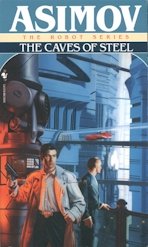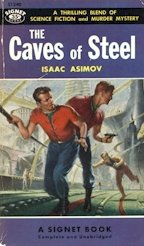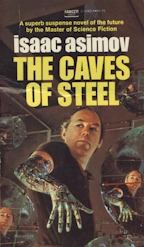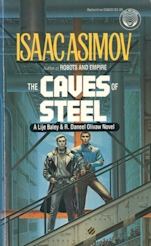
A Robot Novel
Current Bantam Spectra paperback
cover art by Stephen Youll
270 pages (left)
1950s Signet Books edition
189 pages (right)

Denver Science Fiction & Fantasy Book Club |
 |
The Caves of Steel (1953,1954) A Robot Novel Current Bantam Spectra paperback cover art by Stephen Youll 270 pages (left) 1950s Signet Books edition 189 pages (right) |
 |
|
Character list More Caves of Steel covers Our book ratings |
Aaron's Commentary Isaac Asimov bibliography Links |
 |
more book covers The Caves of Steel 1970s Fawcett paperback 191 pages (left) 1980s Del Rey paperback Cover art by Michael Whelan 268 pages (right) |
 |
| Dan | 7 | Amy | 7 |
 |
10 Wow! Don't miss it 8-9 Highly recommended 7 Recommended 5-6 Mild recommendation 3-4 Take your chances 1-2 Below average; skip it 0 Get out the flamethrower! U Unfinishable or unreadable - Skipped or no rating given |
| Cheri | 7 | Barb | 7 | ||
| Aaron | 9 | Cynthia | 7 | ||
| Lucy | 6 | Jackie | 8 |
|
Aaron's Commentary
Isaac Asimov - The Caves of Steel
I enjoyed The Caves of Steel more than I expected to. In particular, the science fiction detective story format worked much better than I anticipated. For many years I put off reading this book for fear that it would be just a standard whodunit dressed up in SF trappings. Instead, it's a terrific SF novel that happens to have a detective story driving the plot, just as another SF novel might have a love story or a quest driving its plot. The characterization of Baley and Olivaw is very good. Baley's foibles and fallibility made him far more interesting than your typical Hercule Poirot-style supersleuth. Olivaw demonstrates Asimov's knack for writing appealing robot characters. He always behaves logically and within the parameters of his programming, yet somehow manages to convey his own personality and to display a sense of loyalty. The side characters are not as strong, particularly the wife (even if having her self-image derive from her name was a nice touch). I was very interested in the setting, Asimov's clustered, agoraphobic society. I find it an unlikely scenario for the future - it's hard to imagine people living their entire lives indoors when green pastures are right outside an unlocked door - but Asimov made it seem plausible. The novel is filled with other great SF concepts: the use of robots to examine topical issues of prejudice and racism; the notion of C/Fe, a philosophy of diversity that may have inspired Gene Roddenberry's comparable concept of IDIC; the illustration of the dangers of stagnation in its various forms, including both the endless struggle to survive in the communistic system on Asimov's future Earth, as well as the privileged complacency of the Outer Worlds. In hindsight, with the Outer Worlds' form of stagnation, Asimov may have identified the greatest danger that our society now faces. What do you think? Your comments are welcome. Please send them to vanaaron@excite.com |